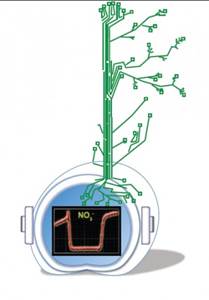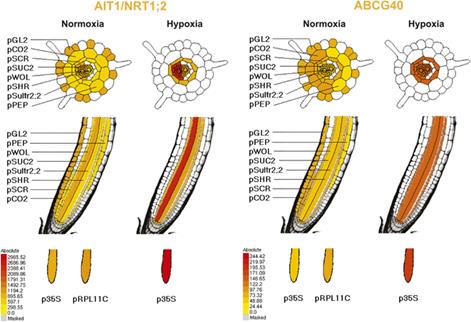

The NiTrac sensor developed by Cheng Hsun Ho and Wolf Frommer of the Carnegie Institution will enable non-invasive real-time monitoring of nitrogen acquisition in action in plant roots, providing a new tool set that can be used to improve nitrogen efficiency. The novel sensor technology is widely applicable and useful also for cancer and neurobiology.

关于洪水和干旱的新闻越来越多,气候专家说其频率在未来会更高。因此,科学家们更多地了解这些极端事件对植物的影响,从而应对由此导致的食品安全风险是至关重要的。新的工作将有助于实现这方面的突破性发现。
像动物一样,植物也通过激素在细胞间发送化学信号,传达植物发展或与外部环境之间互作的信息。植物使用激素信号的一个特殊方面在于对干旱或土壤盐度的反应。负责此反应的激素称为脱落酸。它不仅控制水份利用效率,而且在种子保持休眠和发芽的时间信号中也发挥作用,这取决于土壤条件。
包括Carnegie's Wolf Frommer在内的研究团队的新工作将首次允许研究人员能够实时测量单个植物细胞的脱落酸含量。研究结果发表在《eLife》。
“这将大大提高我们对‘脱落酸在盐胁迫或缺水植物中如何发挥作用’的理解,”Frommer解释说。“这个新工具可以帮助工程师和农民增加作物产量,这对由于气候变化而使植物处于增加的环境压力情景尤其重要。”
研究团队的工具使用多荧光标记蛋白来测量植物细胞中的脱落酸浓度。他们的发现表明,可能有比目前已知的更多的蛋白质负责运送脱落酸进入细胞,同时,摄取后脱落酸很快被根系细胞消除。
“应该有更多的工作来揭示植物细胞对激素信号的响应和应答微调。这些工具也可以应用于人类和动物激素,”Frommer说。(编译:中国科学院成都生物研究所 王芋华,王海燕)
Abscisic acid dynamics in roots detected with genetically encoded FRET sensors
Abstract Cytosolic hormone levels must be tightly controlled at the level of influx, efflux, synthesis, degradation and compartmentation. To determine ABA dynamics at the single cell level, FRET sensors (ABACUS) covering a range ∼0.2–800 µM were engineered using structure-guided design and a high-throughput screening platform. When expressed in yeast, ABACUS1 detected concentrative ABA uptake mediated by the AIT1/NRT1.2 transporter. Arabidopsis roots expressing ABACUS1-2µ (Kd∼2 µM) and ABACUS1-80µ (Kd∼80 µM) respond to perfusion with ABA in a concentration-dependent manner. The properties of the observed ABA accumulation in roots appear incompatible with the activity of known ABA transporters (AIT1, ABCG40). ABACUS reveals effects of external ABA on homeostasis, that is, ABA-triggered induction of ABA degradation, modification, or compartmentation. ABACUS can be used to study ABA responses in mutants and quantitatively monitor ABA translocation and regulation, and identify missing components. The sensor screening platform promises to enable rapid fine-tuning of the ABA sensors and engineering of plant and animal hormone sensors to advance our understanding of hormone signaling.
原文链接:http://elifesciences.org/content/3/e01741



